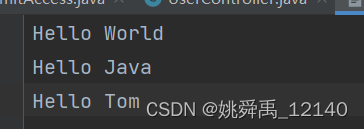SpringBoot+Redis实现接口防刷的示例代码
作者:姚舜禹_12140
在实际开发中,会出现用户多次点击发送请求,本文主要介绍了SpringBoot+Redis实现接口防刷的示例代码,具有一定的参考价值,感兴趣的可以了解一下
场景描述:
在实际开发中,当前端请求后台时,如果后端处理比较慢,但是用户是不知情的,此时后端仍在处理,但是前端用户以为没点到,那么再次点击又发起请求,就会导致在短时间内有很多请求给到后台,可能会出现后台崩溃或者数据重复添加的问题。那么如何解决这个问题呢?
为了避免短时间内对一个接口访问,我们可以通过AOP+自定义注解+Redis的方式,在接口上加一个自定义注解,然后通过AOP的前置通知,在Redis中存入一个有效期的值,当访问接口时这个值还未过期,则返回提示信息给前端,以此来避免短时间内对接口的方法。
本文以一个文件下载的接口为例:假设文件下载会在20S内完成,当第一次下载的时候,在redis中存入一个key,并设置其过期时间为20s。当后续发起多次请求的时候,提示:访问过于频繁。先准备一个文件:


实现过程:
(1)创建一个自定义注解,其中包括两个属性,一个是key,一个是key在Redis中的有效时间
import java.lang.annotation.ElementType;
import java.lang.annotation.Retention;
import java.lang.annotation.RetentionPolicy;
import java.lang.annotation.Target;
@Target(ElementType.METHOD)
@Retention(RetentionPolicy.RUNTIME)
public @interface LimitAccess {
/**
* 限制访问的key
* @return
*/
String key();
/**
* 限制访问时间
* @return
*/
int times();
}
(2)创建对应的切面
import com.example.demo.anno.LimitAccess;
import org.aspectj.lang.ProceedingJoinPoint;
import org.aspectj.lang.Signature;
import org.aspectj.lang.annotation.Around;
import org.aspectj.lang.annotation.Aspect;
import org.aspectj.lang.annotation.Pointcut;
import org.aspectj.lang.reflect.MethodSignature;
import org.springframework.beans.factory.annotation.Autowired;
import org.springframework.data.redis.core.RedisTemplate;
import org.springframework.stereotype.Component;
import java.util.concurrent.TimeUnit;
/**
* AOP类(通知类)
*/
@Component
@Aspect
public class LimitAspect {
@Autowired
private RedisTemplate redisTemplate;
@Pointcut("@annotation(com.example.demo.anno.LimitAccess)")
public void pt(){};
@Around("pt()")
public Object aopAround(ProceedingJoinPoint pjp) throws Throwable {
// 获取切入点上面的自定义注解
Signature signature = pjp.getSignature();
MethodSignature methodSignature = (MethodSignature) signature;
// 获取方法上面的注解
LimitAccess limitAccess = methodSignature.getMethod().getAnnotation(LimitAccess.class);
// 获取注解上面的属性
int limit = limitAccess.times();
String key = limitAccess.key();
// 根据key去找Redis中的值
Object o = redisTemplate.opsForValue().get(key);
// 如果不存在,说明是首次访问,存入Redis,过期时间为limitAccess中的time
if (o == null) {
redisTemplate.opsForValue().set(key, "", limit, TimeUnit.SECONDS);
// 执行切入点的方法
return pjp.proceed();
} else {
// 如果存在,说明不是首次访问,给出提示信息
return "访问过于频繁";
}
}
}
(3)在需要限制的接口上,加上注解,并设置key和限制访问时间
@GetMapping("/download")
@LimitAccess(key = "download_key", times = 20)
public String downLoadFile(HttpServletRequest request, HttpServletResponse response) {
FileInputStream inputStream = null;
BufferedInputStream bufferedInputStream = null;
OutputStream outputStream = null;
try {
File file = ResourceUtils.getFile("classpath:template/show.txt");
if (file.exists()) {
String fileName = file.getName();
String mineType = request.getServletContext().getMimeType(fileName);
response.setContentType(mineType);
response.setHeader("content-type", "application/form-data");
response.setHeader("Content-disposition", "attachment; fileName=" + fileName);
inputStream = new FileInputStream(file);
bufferedInputStream = new BufferedInputStream(inputStream);
outputStream = response.getOutputStream();
int len = 0;
byte[] buff = new byte[1024];
while ((len = bufferedInputStream.read(buff)) != -1) {
outputStream.write(buff, 0, len);
}
} else {
return "下载的文件资源不存在";
}
} catch (Exception e) {
e.printStackTrace();
} finally {
try {
if (inputStream != null) {
try {
inputStream.close();
} catch (IOException e) {
throw new RuntimeException(e);
}
}
if (bufferedInputStream != null) {
bufferedInputStream.close();
}
if (outputStream != null) {
outputStream.flush();
outputStream.close();
}
} catch (IOException e) {
e.printStackTrace();
}
}
return "success";
}测试结果:
第一次访问:

第二次访问:

当download_key过期后,则可以继续下载!
到此这篇关于SpringBoot+Redis实现接口防刷的示例代码的文章就介绍到这了,更多相关SpringBoot Redis接口防刷内容请搜索脚本之家以前的文章或继续浏览下面的相关文章希望大家以后多多支持脚本之家!
